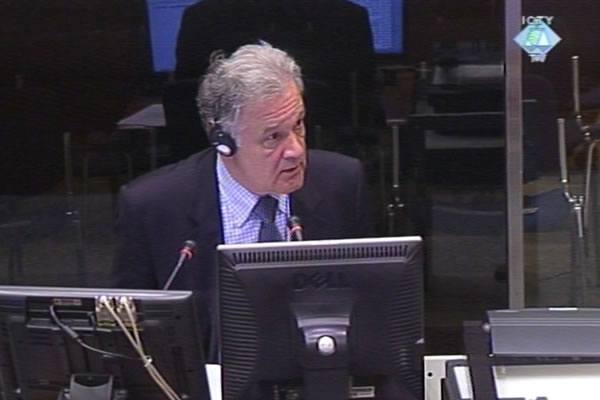Home
CROATIAN JUDICIARY AGAINST THE 'STAMPEDE PHENOMENON'
Describing the situation in Krajina after Operation Storm, Ivan Galovic, public prosecutor from Zadar, said that in the second half of 1995 there was a ‘stampede phenomenon’ there: Croat returnees and common criminals looted the abandoned Serb villages. In his evidence in Gotovina’s defense Galovic said that the Croatian judiciary had tried to fight this with everything it had
 Ivan Galović, svjedok odbrane Ante Gotovine
Ivan Galović, svjedok odbrane Ante Gotovine In his evidence for Ante Gotovina’s defense district public prosecutor from Zadar Ivan Galovic claimed that after Operation Storm the Croatian civilian judiciary prosecuted all crimes perpetrated by former members of the Croatian Army. The defense will use his evidence to contest the allegation in the indictment that generals Gotovina, Cermak and Markac were responsible for creating an atmosphere of impunity resulting in numerous crimes against Serb civilians. As alleged by the prosecution, this contributed to the Serbs’ exodus and prevented Serb refugees from returning.
Defense counsel Kehoe produced several reports drafted by the Zadar public prosecutor’s office, signed by Galovic. The reports, sent to the Justice Ministry, prove that more than 1,000 criminal reports were filed from August 1995 to February 1996 for crimes committed in Krajina. Most of them deal with looting and robberies; dozens of reports were filed for murder and less than ten for arson and destruction of abandoned Serb houses. The reason behind those figures, Galovic clarified, is that theft is easy to prove because perpetrators are often caught with stolen items in their possession; murder, on the other hand, requires a more serious investigation. It was almost impossible to prove the case for burning and blowing up of houses, Galovic noted, because the police couldn’t catch perpetrators: the area was simply too big.
The prosecutor from Zadar claims that in the chaos after Operation Storm there was a ‘stampede phenomenon’; different categories of persons stampeded into the liberated area. The two dominant groups in the stampede were the Croat returnees who had been expelled from their homes between 1991 and 1995 and the criminals whom Galovic labeled ‘vultures’ or ‘small-time thieves’. The first looted in revenge. In their defense before the court they would argue that they just ‘went to collect their things’. The other group looted whatever they could, including items from the house owned by witness’s mother-in-law in Karin. In Galovic’s view, the same people looted and burned down houses. When they stood trial later, they defended themselves saying that they just ‘rescued those things from burning houses’.
In late 1995, Galovic issued an indictment against a group of Croatian soldiers, charging them with murder of 16 Serb civilians in the villages of Varivode and Gosici. The group of demobilized soldiers had been wandering around Krajina villages ‘on their own’, looting and killing Serb civilians. As the witness put it, he was ‘unpleasantly surprised’ when they were acquitted. The Supreme Court then granted his appeal and ordered a re-trial. The judiciary districts were redrafted at that time, and the trial continued before the court in Sibenik. Zeljko Zganjer, public prosecutor from Sibenik, soon gave up on the prosecution, primarily because the accused claimed that they had given their statements to the police under duress. The murder of Serbs in Varivode and Gosici has not been closed yet.
Before the hearing ended today, prosecutor Mahindaratne began cross-examining the witness.
Linked Reports
- Case : Gotovina et al. - "Operation Storm"
- 2009-07-01 'CRIMINAL AND KILLER' DEFENDING GOTOVINA
- 2009-06-30 MANY WERE CHARGED, BUT THERE WERE NO CONVICTIONS
- 2009-06-26 GOTOVINA VS. STATE OF CROATIA
- 2009-07-03 A THOUSAND QUESTIONS ABOUT A THOUSAND CRIMINAL REPORTS
- 2009-07-07 CLEARING UP AFTER OPERATION STORM
- 2009-07-09 US MILITARY ATTACHE IN GOTOVINA'S DEFENSE
